Report on Incidents on Lake Ice in Northwestern Vermont during the 2012 Season
Compiled by Bob Dill, November 2012
The following are accounts of the 18 incidents we know about. Most of them were on the Vermont side of Lake Champlain and nearby lakes and ponds.
|
|
Incident |
Activity |
Outcome |
Situation |
|
1 |
Broke through |
Skating |
Wet, hit face |
Dodgy ice, Inland Sea |
|
2 |
Broke through |
Skating |
Hit chin |
1/2" ice over hole, Shelburne Pond |
|
3 |
Broke through |
Walking-solo |
Wet to waist |
Thin ice over hole, Shelburne Pond |
|
4 |
Broke through |
Evening skating |
Cold skate to car |
Fold down ridge, Malletts Bay |
|
4A: |
Broke through |
Evening skating |
Cold skate to car |
Fold down ridge, Malletts Bay |
|
5 |
Broke through |
Skating |
Cold skate to car |
Fold down ridge, Malletts Bay |
|
6 |
Broke through |
Solo night skating |
Cold skate to car |
Fold down ridge, Shelburne Pond |
|
7 |
Fell |
Skating |
Broken hip |
Unexpected water, Mallets Bay |
|
8 |
Fell |
Skating |
Concussion |
Had helmet, Dead Creek |
|
9 |
Fell |
Skating |
Broken wrist |
Ordinary fall, Malletts Bay |
|
10 |
Sailed into ridge |
Sailing |
Wet and cold |
Fold down ridge, Mallets Bay |
|
11 |
Sailed 30 ft onto 1" ice |
Sailing solo |
Wet and cold |
Dodgy ice, Inland Sea |
|
12 |
Truck through ice |
Plowing the ice |
Everybody lived |
Snow over black ice. Waterbury Reservoir |
|
13 |
Truck through ice |
Driving at night |
Everybody lived |
Overlapped ridge, Missisoquoi Bay |
|
14 |
Jeep through ice |
Fishing-night |
Driver lived |
Fold down ridge, Mallets Bay |
|
15 |
Truck partially through |
Driving at night- |
Truck ruined |
Fold down ridge, Sandbar |
|
16 |
Truck partially through |
Following #15 |
Truck mostly OK |
Fold down ridge, Sandbar |
|
17
18 |
Snowmobile
Stranded |
Rounding a point
Fishing |
Rescued
Rescued |
Rotten ridge, Sampson Point, St Albans Rotten ridge, Crown Point, Spar Mill Bay |
Note: I should point out that Malletts Bay had the best accessable ice for most of the winter so that accounts for its frequent mention in this list.
Lakeice site pages that relate to specific incidents:
1, 4, 6, 18: Ice Fever
4, 6, 12, 13, 14, 15, 16: Ice at Night -Increased risk associated with ice activities after sunset.
12: Close call on Waterbury Reservoir - A full report
12 to 17: Vehicles on Ice - Why driving on ice is a high risk activity and what can be done to reduce risk.
Locations of incidents on the Inland Sea, Outer Mallets Bay and Inner Mallets Bay (called just 'Mallets Bay' on the map). Yellow marker is #11, Red marker is #1, Blue marker is #15 and 16, Blue thumb tack is #4, 4a, 5, 10, and 14, yellow thumb tack is #7
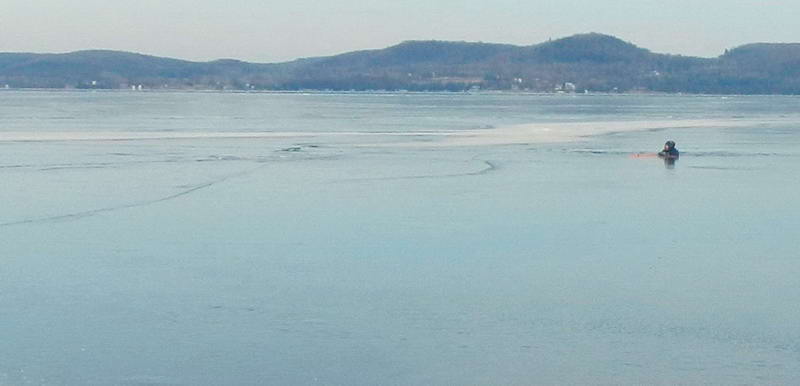 Chris in the drink
Chris in the drink
1: Inland Sea-Lake Champlain Chris, an experienced ice traveler, fell through a skinned over new-ice hole (one of many on this part of the lake in late January 2012). He wrote the following account:
Somebody asked me in the parking lot at appletree bay why i was wearing goggles on such a benign day. much safer than sunglasses if you go through the ice, i responded. i know, sounds like a cheap movie, but (stuff) like that really does happen.
the ice was smooth, the sky was blue, down the lake the nine skaters flew. after six weeks of (less than great) skating ice at home, i felt like somebody had let me out of jail. it was glorious out there, the best ice of my season. free bird was playing in my head.
approaching fish bladder island was a large pressure crack impeding our way north. i skated towards the island to get around the crack, and once through spotted open water off the southwest end of the island. i skated east, found an amazing stretch of #10 ice, and jumped on it without much thought and a lot of energy. Ten strides into it i heard a creak and two strides later i was in the cold soup.
i went completely under but my poles stayed on the ice. i re-surfaced and remembered reading an article about always climbing out of the ice in the direction you came from as eventually you will hit ice strong enough to hold you. so i made like esther williams and spun around.
my goggles had been knocked almost off. i looped them on my arm and tried to climb back up on the ice. it broke beneath me. so i pulled my picks apart, put my hands on the ice and kicked with my feet until my upper body was on the ice. then i used the picks to pull me up on the ice without kicking my feet, which would have broken the ice.
i then slithered and crawled to a point where i thought it safe to stand up and skate. fortunately we were up wind and it was about 30 degrees. i was wearing nothing but neoprene, fleece, and wool beneath my gore-tex, so as i skated in all the water drained into my boots and mittens.
once on shore my friends took charge and ten minutes later i was in a warm house in dry clothes. ate some chili and drank a bit of vino to get the system running again. mucho gracias, deb and jay
i was lucky in many ways. didn't lose any equipment, only suffered a fat lip when my chin hit the ice, and was wearing the right clothing. the goggles did save me from facial cuts, and i can't say enough swell things about the picks phelps made for me so many years ago. i also couldn't ask for better companions on the ice, and am sorry for any distress i caused you. now i know what the kid who got sick at the birthday party felt like.
it's weird going from on top of the world to the bottom of a cold cold lake in a flash of a second. i could have been more cautious, but that's pretty much the on-going story of this crash'n burn life i have been living since learning to walk. somebody said it was like vince jumped into my body, but there's a bit of vince in all of us who love black ice.
now, let's get back out there and practice safe skating, and keep your goggles on...
A follow up comment from Chris on clothes:
bob,while many ice people do not have wet or dry suits, it should be stressed that cotton is the enemy when wet. wool, fleece, neoprene and gore-tex are the only clothing that should be worn when on the ice.
2: Shelburne Pond, VT, late December 2011. A skater out with a few friends broke through a thinly skinned hole close to the swampy edge of the north end of the pond. The breakthrough could have been more violent as the victim, who is a regular hockey player, had been skating at full speed in the same general area just a few minutes before finding a 3 foot diameter hole with a 1/2" ice skin. Even at the modest (5 mph?) speed he was moving when he fell through he hit his chin hard enough to need a stitch.
Shelburne Pond: From top to bottom, locations of incidents 2, 6 and 3,
3: Lone walker breaks through thin spot on Shelburne Pond) A day after incident 2 we were putting on our skates when a solo walker headed out onto the ice. We were about to head over to warn him about possible thin ice near the swampy edge of the south end when he fell through. He climbed out quickly, wet and muddy to his waist. He said he had stayed close to the edge so it was likely to be shallow if he broke through. A test pole could have avoided using the 'body weight test method' to find thin ice.
4 and 4A: Two friends on an 'after work' skate tour. They skated from Bay Shore Park on Inner Mallets Bay and went to the Outer Bay on January 26, 2012 (sunset was 4:51PM). They both fell into a fold down pressure ridge at the same place that 1/4 of this year's incidents took place. The following is John's first person account:
The 2012 Right and Wrong way around Cave Island: Black = overlapped section of the bay-mouth ridge. Red = fold down ridges. Green = the way around the ridges. Blue pin = where four incidents took place.
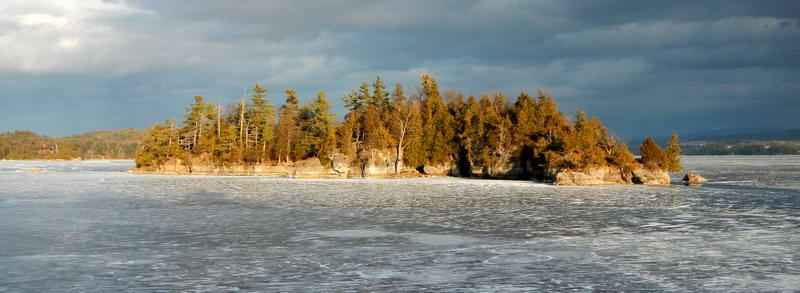 Cave Island looking NE. The usual pressure ridge runs north from the left end of the island across the narrows between inner and outer Mallets Bay. The ridge free passage around the island comes around the right end and up to the left.
Cave Island looking NE. The usual pressure ridge runs north from the left end of the island across the narrows between inner and outer Mallets Bay. The ridge free passage around the island comes around the right end and up to the left.
I promised bob dill to post, so here's the story....hopefully someone can learn something from our swimming-lesson...
checked the message board early last thursday and that's when it all started....the black ice fever that is...i had to work most of the day and picked up my friend and made it to bayside park about 4:15....saw a bunch of people on their way in...some still out there....."#10 #10 #10" they all said with reverence, awestruck looks on their faces..we raced out past marble island with each stretch of black ice seemingly better than the last...
......at a bit past 5, and out into the great bay, we forced ourselves to turn around as we knew it would be dark all too soon....heading home just southeast past marble island we ducked into a beautiful cove with more of the good stuff everywhere...we were intoxicated...then, coming back out of that bay, chattering away to each other, skating at close to full speed, not paying much attention, and with the light fading we cut it too close to shore and right on one of the pressure ridges...
......CRACK...WATER....COLD....HOLY #!#!#!!?!!...PANIC....We both had picks (one set that bob dill gave me earlier this season south of the bridge, tks bob), i was wearing a lifejacket and had a rope too...I turned around and saw my friend was also in the water..while reaching forward to grab the ice and pull myself out, the 3/4" inch thin layer of ice kept breaking away (i now know to go back the way i came from tks to GOCARMI's earlier post THANKS FOR THE TIP!)....anyway, i was horizontal in the water, then realized i could stand and my poles where hitting something underneath me... (according to Bob it was probably the ice plates that had been pushed down below the pressure ridges)...took us both about 20/30 seconds of breaking through some thin stuff to basically walk out of the water and onto thicker ice...we were both soaked..i busted my lip and scraped up my face on the ice....my buddy took a shot in the midsection....thank goodness the temps were in the 30's..wasn't too bad skating in with soaked clothes...adrenaline level was HIGH....
we got in and i quickly realized that the laces on my skates (the hockey variety) were FROZEN, thank goodness i had not double knotted them or I would not have been able to get them untied and off my feet without a knife to cut the laces (a knife which i did not have)....we hurried up to the car and put on the dry clothes that we had and cranked the heat....fortunately, we warmed up pretty quickly....
pretty scary...i chalk up skating where we did (over a pressure ridge close to shore) mostly to the fact that the light was low but there was definitely an element of complacency...i just quit paying attention on the way back in!!!
thank you to everyone on this board who has posted ice reports/safety measures etc. etc. over the years....being out on the wild ice and sharing the experience with a number of you has been a true joy and i look forward to many more adventures.....cheers - john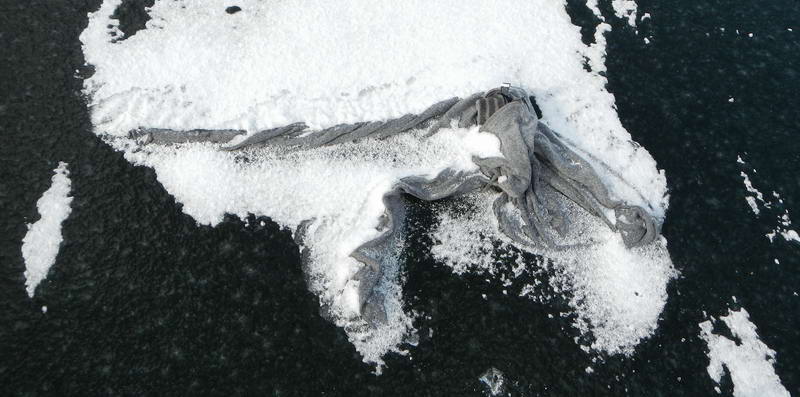 #4: John's sweater, now frozen onto the ice. He recovered it by sawing it out of the ice. With a 6" ice thickness it was a heavy block.
#4: John's sweater, now frozen onto the ice. He recovered it by sawing it out of the ice. With a 6" ice thickness it was a heavy block.
5: A lone skater skated into the same ridge at about the same place. Even though he did not break through fully he got pretty wet.
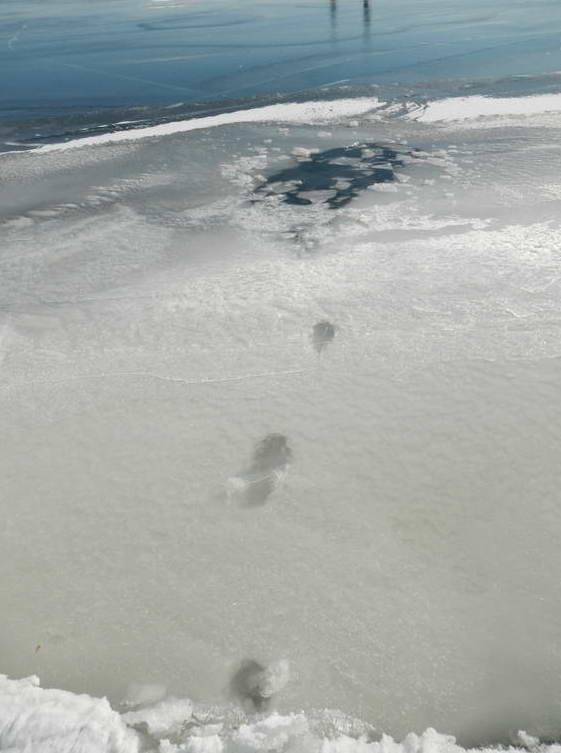 The person in incident 5 skated onto this rotten snow-ice filled fold down ridge and stumbled for a three steps before breaking through just short of the far side.
The person in incident 5 skated onto this rotten snow-ice filled fold down ridge and stumbled for a three steps before breaking through just short of the far side.
6: A lone, night time skater fell in a known, persistent hole in the center of Shelburne pond. He was able to get out quickly in spite of not having ice claws. He will be sending a first person account soon.
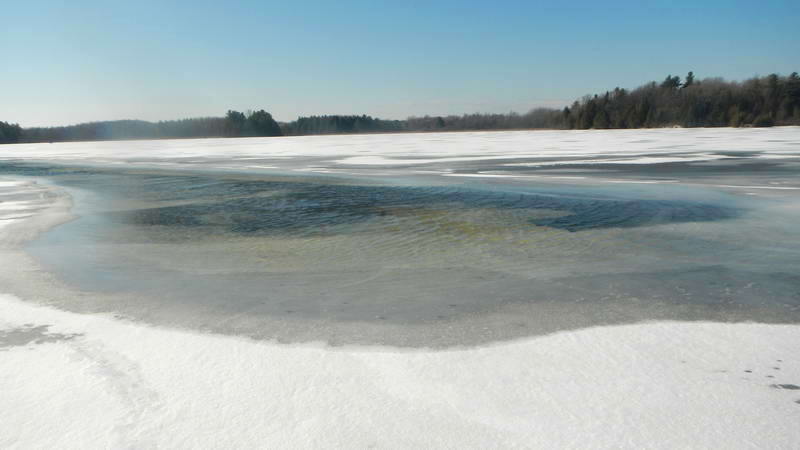 The southern end of the double ended fold-down ridge that stayed active and open for almost the entire winter on Shelburne Pond. This is most likely not where the skater fell in.
The southern end of the double ended fold-down ridge that stayed active and open for almost the entire winter on Shelburne Pond. This is most likely not where the skater fell in.
7: Skater breaks hip in fall on Mallets Bay: A group of about 10 skaters was out for a casual afternoon skate on Inner Mallets Bay. They had stopped to plan the next phase of their trip. As the victim skated up to them he spotted water just off his path. He got crossed up while trying to stop himself quickly and fell hard onto his hip. He was in considerable pain but thought he could skate back in. Once on his feet he was still in a lot of pain. I ended up towing him with a throw rope about 3/4 mile on his skates. In retrospect that was not the best available transport choice as the risk of a second fall was significant. For example we could have hailed a nearby DN iceboat. Once at shore it was obvious that a hospital visit was in order and Rescue was called. His age and bone condition may have contributed to the break. He has made a nearly full recovery and his average bone density has been slightly increased with the addition of some expensive stainless steel screws.
As we discussed the accident on the Vermont Nordic Skaters forum, several people reported hard falls on their hips when board and kite sailing. They had been wearing hip pads when doing these things. Hip and coccyx (tail bone) protection is a good idea for older skaters as well. (More on impact protection).
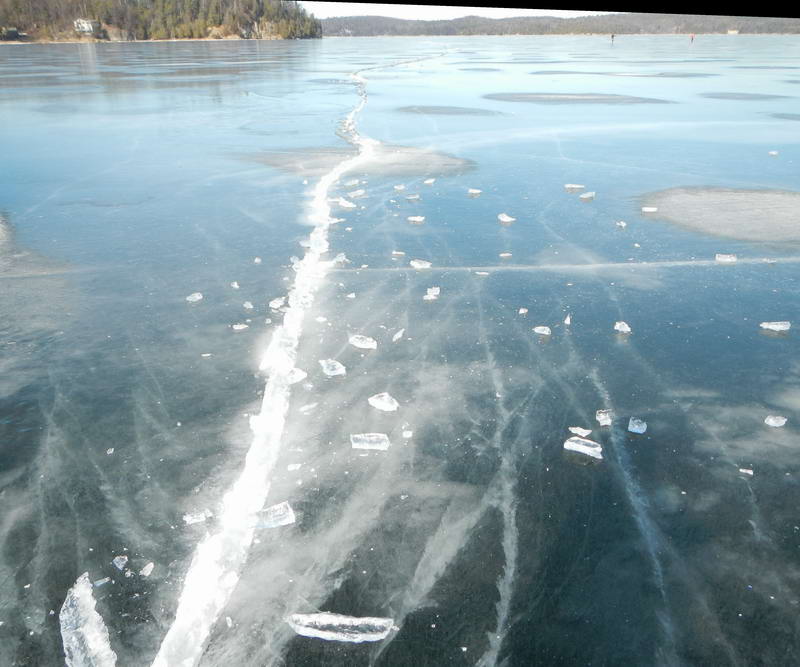 The spring techtonic is closed hard from thermal expansion in the ice sheet. It is spalling off crushed ice from its edges. It is common for puddles and holes to from along these cracks.
The spring techtonic is closed hard from thermal expansion in the ice sheet. It is spalling off crushed ice from its edges. It is common for puddles and holes to from along these cracks.
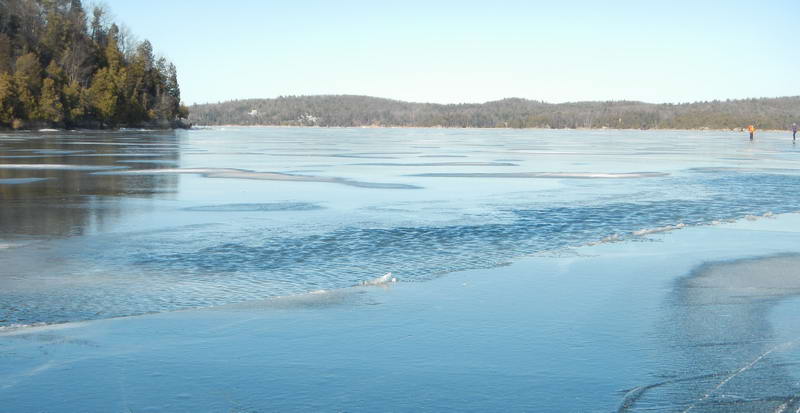 The water that caused the victim to make an abrupt stop that ended in a hard fall. The 6" deep puddle is here because the crack sides are nor vertical so the ice sheet expansion pressure is causing the near plate to rise and far plate to be depressed.
The water that caused the victim to make an abrupt stop that ended in a hard fall. The 6" deep puddle is here because the crack sides are nor vertical so the ice sheet expansion pressure is causing the near plate to rise and far plate to be depressed.
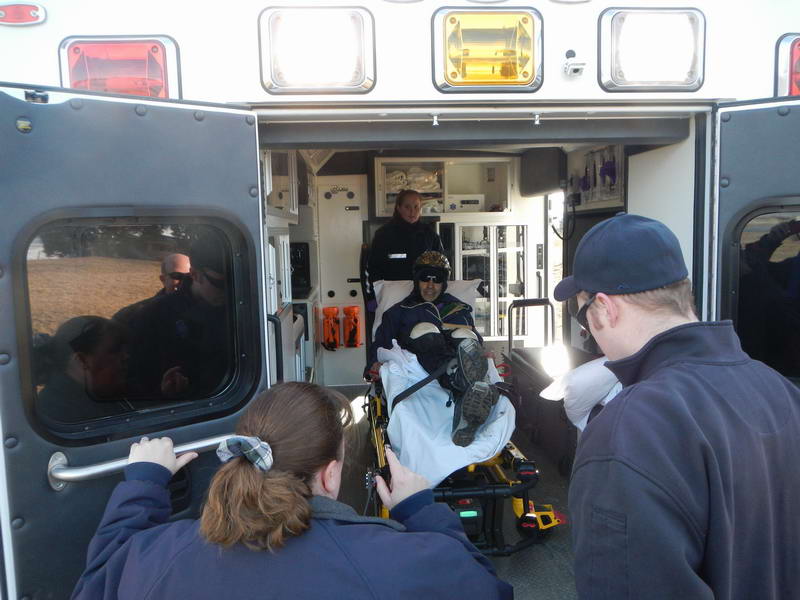 Off to the hospital
Off to the hospital
8: Concussion from a fall on Dead Creek. A group of about half a dozen skaters was doing a tour on Dead Creek about 30 miles south of Burlington VT. One of the group, a skilled, elder, skater, fell and hit his head. The fall appears to have been a 'weight-too-far-back--feet-go-out-from-under-you' fall. This type of fall has been experienced by many skaters and is why most of them now wear helmets. (More on helmets). The following is a first person account of the situation:
Today (Feb 11, 2012) a group of 6 of us skated at Dead Creek. After more than an hour on the ice, Jan had a nasty fall on his back and bumped his head. He got up quickly, and Kristina and I skated over to check how he was feeling. We asked him to do a quick body scan, and he assured us he was OK and wanted to keep skating.
A short while later, I asked again how he felt. He was surprised at my concern, and after a couple more questions I realized that he had no memory of the fall. Scary. We all went back to the car immediately, and Jan way very disoriented. He didn't remember the fall or where we were.
I drove him to the hospical and his memory seemed to mostly return during the drive (though he still didn't remember the skate back to the car and was pretty foggy). At the hospital he was diagnosed with a concussion and the staff was very happy to hear that Jan had a helmet on. A CT scan, thankfully, revealed no damage, and he's now home resting in a dark, quiet room with a bit of a headache.
For me, at least, a couple of safety lessons learned: first, getting up quickly after a fall is not an indication that there's no injury. In fact, a more normal response would have been to take a minute to check for injuries himself. And second, a more careful Q&A was needed after a fall like that. If I had simply asked if he remembered falling or if he knew where he was (seems like typical amnesia-related questions), we might have been off the ice a bit sooner. I should know better, having had a very similar experience with a nasty mountain bike crash several years ago. I got up quickly, got back on my dinged up bike and kept riding. It was only after 10 minutes or so that I realized that I didn't know what the heck was going on...
I'm just glad that he seems to be OK.
Have fun, keep skating and be careful, too many injuries lately!
Dave
Follow up email responding to a question about if Jan had a helmet:
Thankfully, Jan was indeed wearing a helmet.
This is probably the most important lesson for me: a helmet is a VERY good thing to wear on the ice!
Today was the first day I ever skated with a helmet; I will certainly wear one from now on. Funny, I always wear one while roller blading, why wouldn't I on the ice?
Dave
Another follow up comment on the reason for the fall:
It may be worth adding that a contributing factor (if not THE reason) for the initial fall was the very strong gusting wind. Jan was standing still with his back to the wind and may have leaned back into a strong gust. I suspect that the gust died suddenly, catching him with his weight behind the skates and causing his feet to slip out from under him.
Dave
Many years ago a man in street shoes had a similar fall when standing on ice watching us sail in winds gusting into the high 30's. He was not wearing a helmit and spent two days in the hospital....Bob
The usual tour on Dead Creek is to start at the blue marker and go to and return from the red marker. It is about 15 miles and often has areas of thin ice and/or open water.
9: A skater fell while skating with friends and broke her wrist. The details are not clear however it sounds like she was tripped by something. As a general statement, people fall at least once every few trips on lake ice. Snow drifts, small cracks, vertical offsets, shell ice and improperly placed skating poles are all sources of falls.
10: A sailor coming from a regatta sailed into a skinned over fold down ridge. It was the same place on the same ridge that incident 4, 4a, 6 and 14 took place on. When the fleet went out in the morning the ridge had not extended all the way to Cave Island (see map with incident 4). In the afternoon the folded ridge had extended to within 20 feet of the island, affording a narrow passage. The victim tried to sail across the ridge about 100 feet north of the island; roughly where he had crossed in the morning. A thin layer of new ice helped hide the deep puddle over the folded plates. He got wet from below mid chest. He was rescued by other boats following him in. Once on shore he insisted on de-rigging and packing his boat before going inside for a warm shower in spite of several offers to pack up his boat for him. I am not sure if he was affected by his cold condition or was just being stubborn. He finally relented, his friends finished packing his boat and he really enjoyed a warm shower and some dry clothes.
The boat and skipper are supported on one of the downfolded plates under the ridge. With the ice skin on the ridge pond and the frost on top of the skin it is easy to understand why this was hard to see. Having said that, there were lots of indicators that suggested there was a ridge here. Some iceboaters have a bad habit of trying to sail over things they should stop and check out. Most of the time it works out OK, but sometimes, not so well.
11: A lone cruising sailor sailed about 30 feet out onto 1" ice before his boat broke through. He is a pretty experienced iceboater and had ice claws and an ice axe (for testing) but no cold water clothing, life jacket or buddy in another boat. He was a few hundred feet from where ncident #1 took place near Cedar Island on the Inland Sea. With his ice claws he quickly thrashed back to thicker ice and walked about 3/4 of a mile to an inhabited house for some dry clothes and a ride back to his car. He had wool long johns and a wool sweather which he felt helped somewhat. We fished the boat out a few days later after the ice had thickened to about three inches.
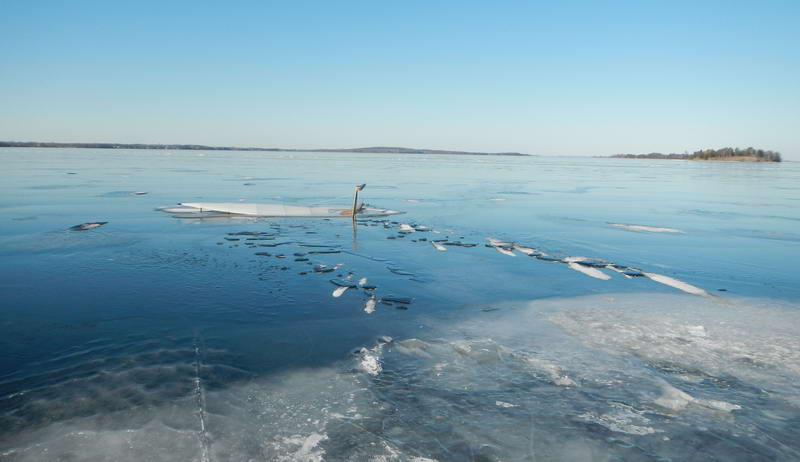 Taken from the thick ice he sailed off of. Pieces of the origional thin plate line the path he clawed through.
Taken from the thick ice he sailed off of. Pieces of the origional thin plate line the path he clawed through.
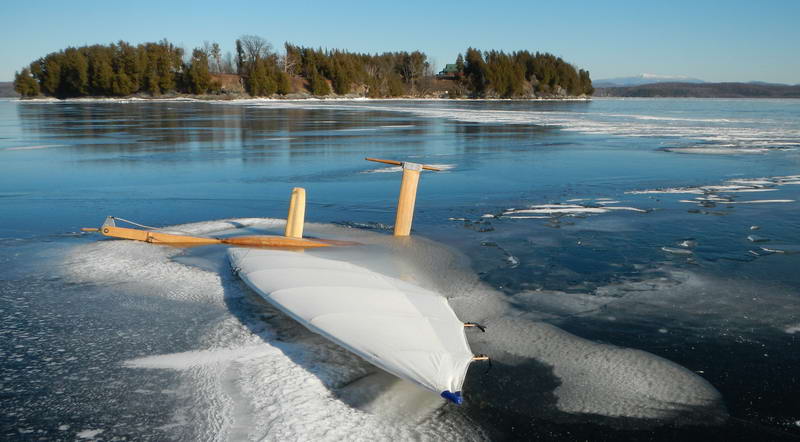 Four cold days later, when the ice was thicker, we fished out the boat.
Four cold days later, when the ice was thicker, we fished out the boat.
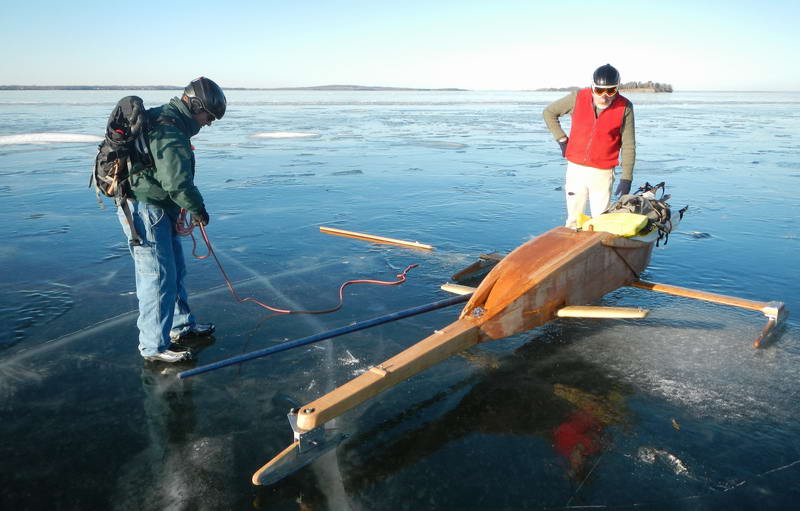
12: Plowing snow on Waterbury Resevoir. A truck with two occupants was plowing snow on ice that was not as thick as they thought. Click here for a detailed account.
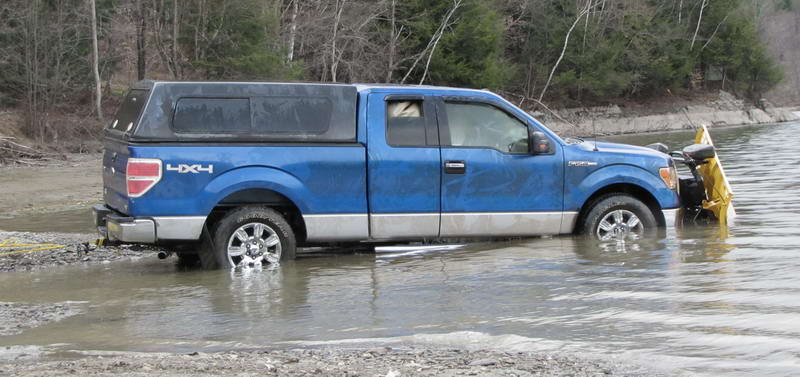 Removal from Waterbury Resevour in April.
Removal from Waterbury Resevour in April.
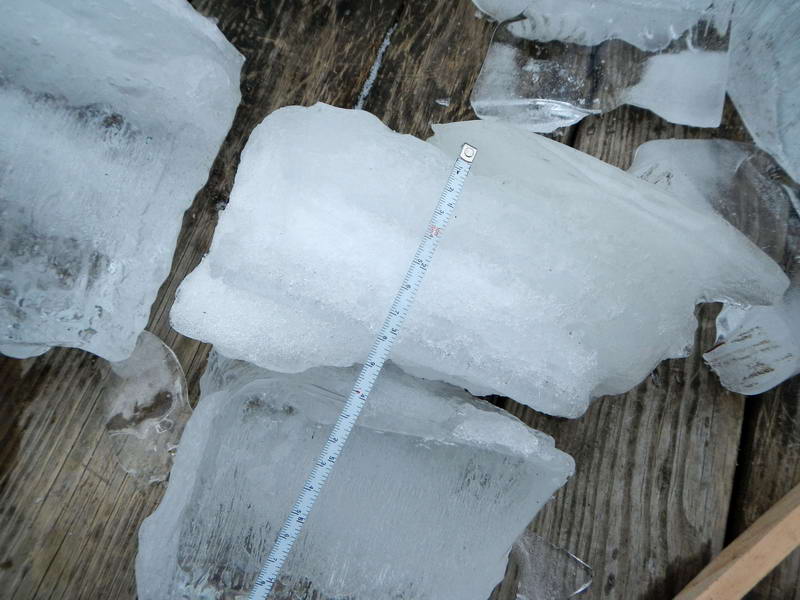 In places the ice consisted of about 3.5" of snow ice on top, with an inch or so of slush between the snow ice and the underlying 4-3/4" of S1 black ice..
In places the ice consisted of about 3.5" of snow ice on top, with an inch or so of slush between the snow ice and the underlying 4-3/4" of S1 black ice..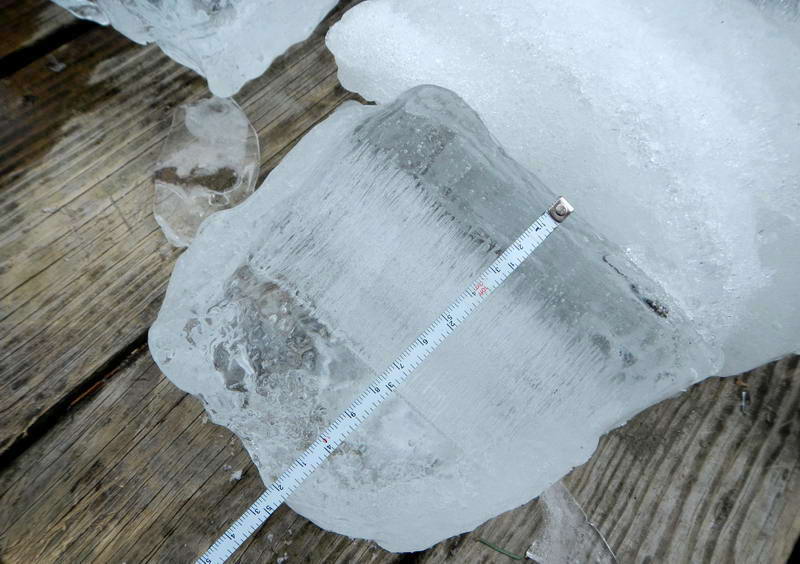 The black ice layer at Waterbury was uniformly about 4-3/4": Almost, but not quite, enough to hold up a truck and plow. Over twice this much black ice should be in place to provide a reasonable safety margin.
The black ice layer at Waterbury was uniformly about 4-3/4": Almost, but not quite, enough to hold up a truck and plow. Over twice this much black ice should be in place to provide a reasonable safety margin.
13: A Canadian truck crossed the border on the ice on Missisoqui Bay. As they approached the shore on the Vermont side they drove into an obvious pressure ridge. They were traveling at night.
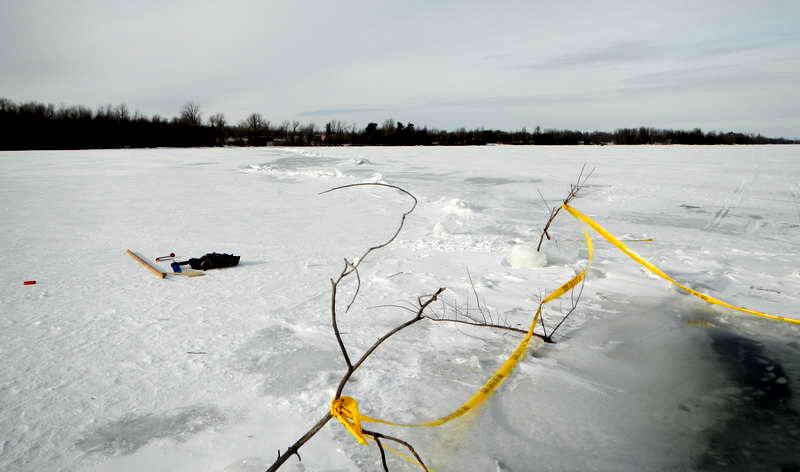 Incident 13: Picture looks NW. The refrozen hole is in the lower right, One of the the incoming tire tracks runs up the right side of the picture.
Incident 13: Picture looks NW. The refrozen hole is in the lower right, One of the the incoming tire tracks runs up the right side of the picture.
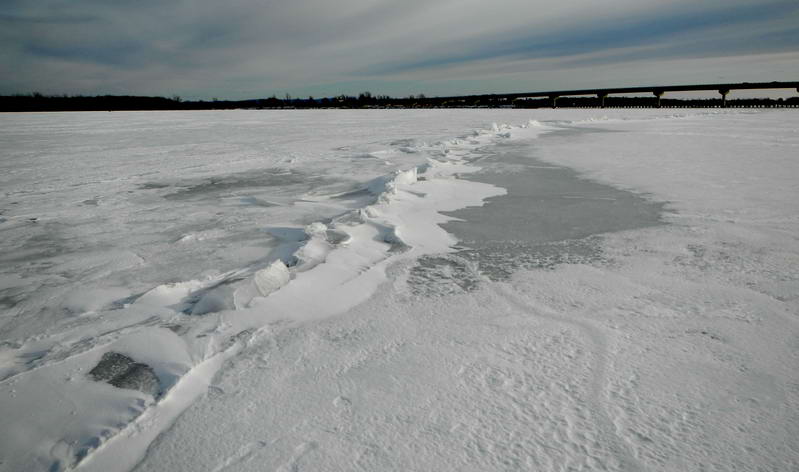 Alberg: The ridge looking south east toward the open water under the bridge. The ridge was not hard to see...
Alberg: The ridge looking south east toward the open water under the bridge. The ridge was not hard to see...
14: Two fisherman returned from fishing on Outer Mallets Bay. They broke through trying to drive across the same fold down ridge that three skaters and an iceboat had fallen through. Lukily they broke through where they did as the car landed on the bottom with roof at water level. A car width or two further north was significantly deeper. The car owner (not in the vehicle at the time) told me his friend used his fist to break the window. (If that is what really happened it is an impressive feat. Don't count on it working for most people-More on getting out of vehicles).
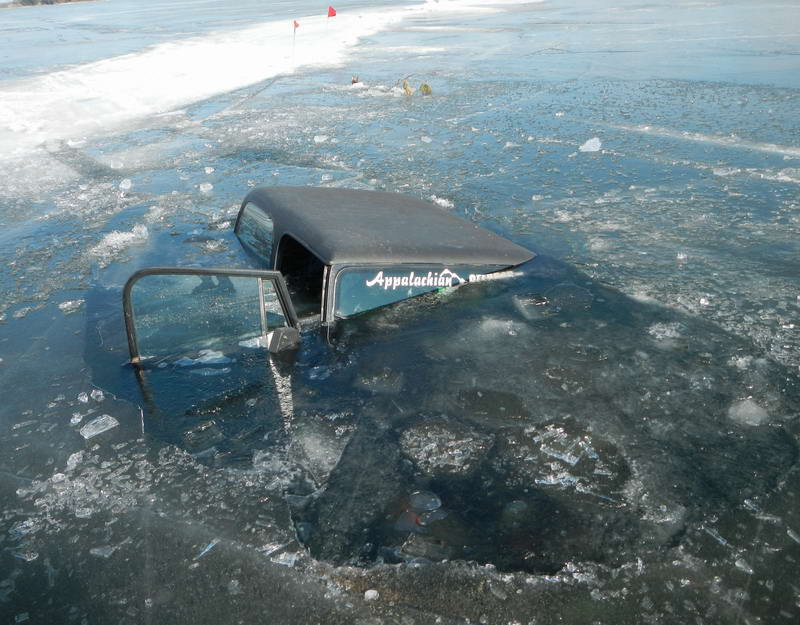
6-1/4" fairly well thawed S2 ice (note the candeling).
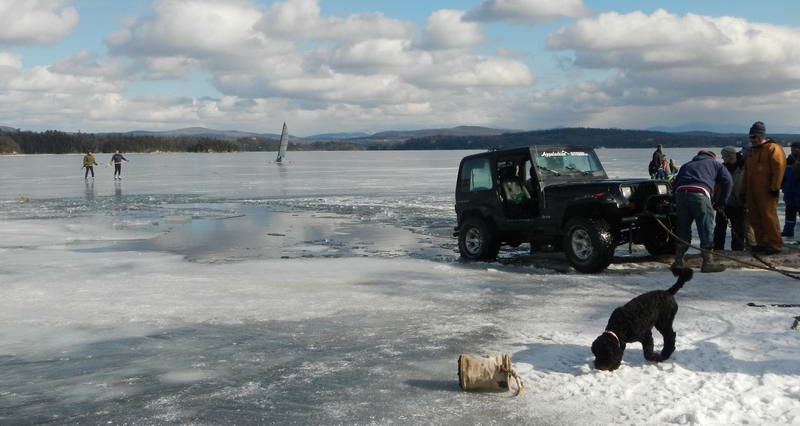 The owner of the Jeep had the vehicle out in a few hours the next day. The vehicle sustained supprisingly little damage. .
The owner of the Jeep had the vehicle out in a few hours the next day. The vehicle sustained supprisingly little damage. .
15: A fisherman drove his truck into a fold down ridge. He broke through near the mouth of the Lamoile River on the northern end of Outer Mallets Bay. He had been fishing overnight during the Lake Champlain Ice-Fishing Derby. He drove to a store for coffee about 5AM. A cold front with attendant snow squalls came in as he was drivng back to his shanty. He got off his route on the return and ended with a partially submerged truck which was extracted a couple days later.
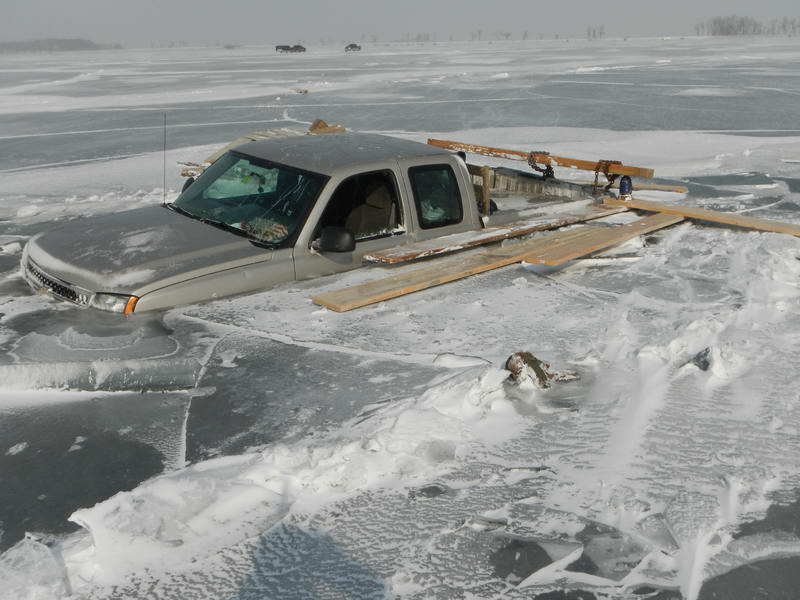 The water was relatively shallow where the truck went through.16: A second truck followed the lights of the #15 truck and broke through in the same ridge. He was able to extract his truck in a couple hours. Fold down ridges had appeared in many places a few days before this, probably attributable to the first warm and sunny day that occurred after the ice came in. The high number of fishermen and vehicles on the ice for the durby, the recent arrival of many folded ridges and the blowing snow to make the ridges more difficult to see all contributed to several four wheelers and a car breaking through this ridge at various places the that morning. All of them were able to get pulled out by mid morning.
The water was relatively shallow where the truck went through.16: A second truck followed the lights of the #15 truck and broke through in the same ridge. He was able to extract his truck in a couple hours. Fold down ridges had appeared in many places a few days before this, probably attributable to the first warm and sunny day that occurred after the ice came in. The high number of fishermen and vehicles on the ice for the durby, the recent arrival of many folded ridges and the blowing snow to make the ridges more difficult to see all contributed to several four wheelers and a car breaking through this ridge at various places the that morning. All of them were able to get pulled out by mid morning.
17) On February 21, 2012 a lone fisherman broke through rounding Sampson Point near St Albans VT. He was coming back from fishing in the mid afternoon. His snowmachine broke through over a reef that had a wide fold down pressure ridge over it. He estimated he was about 70 yards south of Sampson Point. He had gone out in the morning. It had been below freezing for the previous 48 hours with overnight temps in the teens. This apparently hardened up the ice in the ridge so he got over it without incident in the morning. It warmed to 40 degrees in the afternoon. He estimated he was traveling at 15 mph or so when be broke through.
Red line is the ridge between Sampson Point and Woods Island to the west. The green marker is the estimated breakthrough position. The north south section of the ridge (red line) is the approximate position of the reef.
Once the sled settled to the bottom he found he was able to stand on it and get everything above his knees out of the water. He was lucky he went in where he did as a little further out on the ridge the water was 12 feet deep. The southern most 1/3 mile of the point in uninhabited in the winter so it is pretty remote. He could see people in Lapan's bay but they were too far away to hear is calls. He usually does not take a cell phone onto the ice but this day he did. He attributes his three layers of clothing with keeping it dry enough to work. St Albans Rescue got him out of the water. He has fished year round for many years and knows ice well. In retrospect he knew the reef was there and thought he should have stayed a bit further off shore. Based on what I saw a day later I think even that would have been tricky. Going around the ridge on the rocky shore might have been a better alternative.
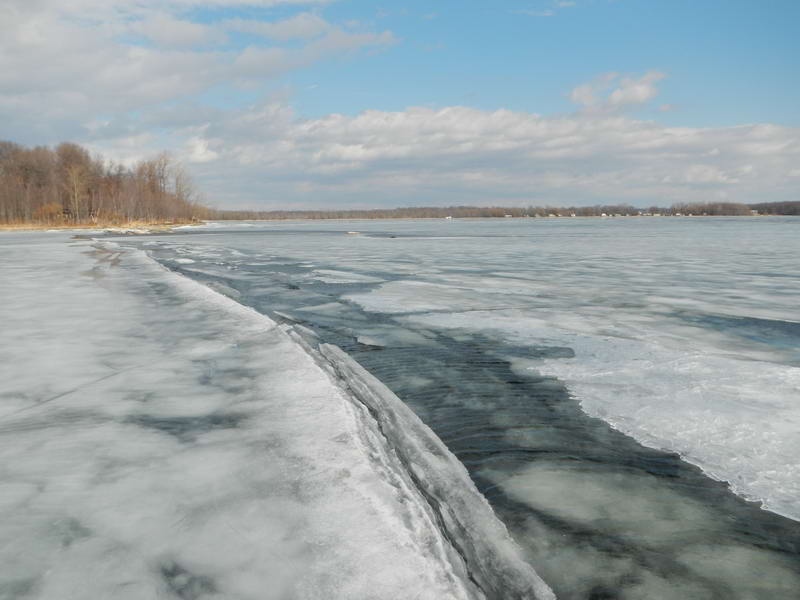 The break through most likely occured about halfway from here to shore. The ice probably looked better the previous day when the incident occured.
The break through most likely occured about halfway from here to shore. The ice probably looked better the previous day when the incident occured.
I visited the scene the next day and found the fold down ridge crossable on foot in only a couple places. As you can see from the picture there were a lot of floating plates in the ridge. These were probably welded in reasonably well when he went out and not so well when he came back in. The previous two weeks had daytime temps had been above freezing on most days, so there had been significant thawing of the ice sheet and ridges. The day I was there reached 50 degrees. The reef may also have contributed to their being thinner ice over and around it although it looked to me like the biggest issue was the condition of the pressure ridge.
Given how easily this could have had a much worse outcome, it worked out pretty well. Ice claws, a flotation type snowmobile suit and a zip-lock bag for the cell phone will substantially reduce risk in a situation like this (as would a friend on another sled with a throw rope).
18) Fishing faimily gets stranded by a sunny day.
WCAX in Burlington reported that a family of eight was rescued near Crown Point NY after the route they took to get to their chosen fishing spot became too weak to get back to shore.
The weather had been mostly below freezing early in the week but got to almost 50 degrees the day before they went fishing. Overnight it dipped to around (possibly a little below) freezing. The day they went out was partly cloudy and it got up to the mid 40's (we were checking ice further north on the lake that day and the ice was weakening so fast that we decided we needed to get off the ice at 11:00).
A larger scale Google Map view of Lake Champlain around Crown Point. The light blue line is open water at a narrow spot in the lake. The dark blue lines indicate the approximate position and width of the melted ridge.
A closer view. The blue marker is where they started from. The red marker is where they (most likely) crossed the ridge and the green marker were there were fish on the ice. The red line approximately marks where the ice got noticeably weaker/thinner as I walked south. One of the rescue people broke through about halfway between the red and blue markers. The ice the fireman broke through was well thawed and 3-1/4" thick. It had lost about 90% of its cold ice strength.
The ice in the area they were fishing was pretty far gone. Crown point is on the southern end of Lake Champlain where the lake has some 'river like' attributes. The ice had melted completely at Crown Point, one of several narrow spots along this part of the lake.
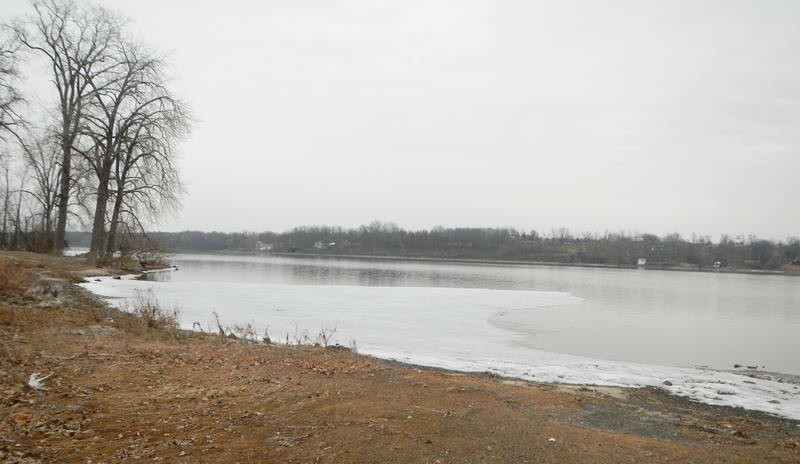 Side to side open water at Crown Point Village
Side to side open water at Crown Point Village
There was a rotten (mostly melted) pressure ridge that ran from point to point along the west shore of the lake (blue lines on the maps). The ridge was mostly open water 15 to 40 feet wide. The ice to the south of the red line was much weaker (thinner). When I visited the next day the ice had firmed up as a result of a 10 hours of below freezing temps overnight. Even with that, the ease with which my test pole went through the ice south of the red line caused me to not go further. The family must have thought the fishing would be better on the other side of the ridge so they crossed it, mostly likely at a relatively small place where the two sides came close together a little south of the red line on the map.
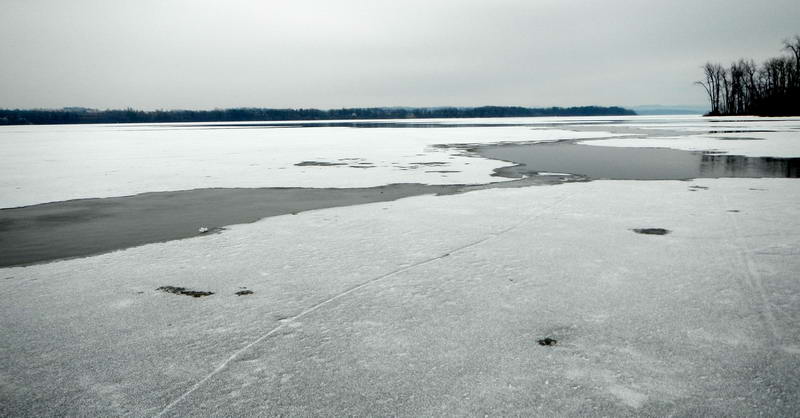 The probable cross over. Picture looking south from the redline on the map above.
The probable cross over. Picture looking south from the redline on the map above.
What they were thinking when they chose to crossed a narrow ice bridge on what was forecast to become a warm day, with kids in tow is a mystery. Happily they had the good sense to call for help rather than having someone break through trying to get back across the ridge.
******************************************************************************
Some thoughts on the 2012 incidents:
- While most skaters involved in breakthroughs had ice claws, test poles and throw ropes, only two had cold water protective clothes or flotation. Only a few of us wear dry suits, wet suits or carry dry clothes. We need to work on making these practices more common.
- Helmet use has become widespread among skaters in the last couple years. The skater in #8 was in his first year of wearing a helmet. His concussion could have been fatal without one. Additionally, it was fortunate that other skaters on the trip noticed the change in demeanor of the victim and got him to a hospital promptly where their preliminary diagnosis was confirmed.
- With the benefit of hindsight, it looks like over 80% of the incidents involved poor situational awareness and/or less than great judgement.
- The local skating and sailing populations are relatively small which results in more solo activity than is desirable. We need to work harder at finding companions to minimize solo trips.
- Most of the vehicle incidents could easily have been fatal. Given the risks involved, situational awareness was low in all cases. The ice was not checked out adiquately, clues to thin ice were overlooked, and driving at night contributed to 80% of the incidents. Windows were not down in most or all cases. In two incidents, tempered glass windows were broken by striking them hard with an elbow or fist. This is probably beyond the capability of many people. A typical car takes from 20 seconds to two minutes to sink to the bottom of the windows. This is not the time to find out if your electric windows really will work when the electrical system gets wet or to try to figure out how to break a window. A proven window breaking tool is highly recommended for anyone driving on ice.
- All the people involved in these incidents that I spoke were more than happy to share what they learned.
'Incident' #19: Now that you have read this far, let me finish by saying thousands of us had a great winter on the ice. Most of the people involved in these incidents will be back on the ice this season. Hopefully, understanding their misfortunes will make it a little more likely that you will stay out of trouble.
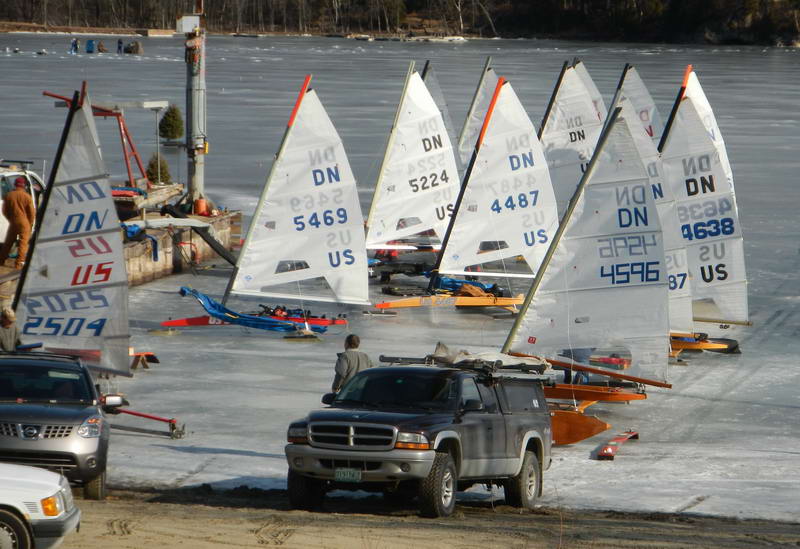 Eastern DN Iceboat Championship on Mallets Bay.
Eastern DN Iceboat Championship on Mallets Bay.
Bob Dill
PS: If you were involved in any of these incidents and have a different perspective or new information, please get in touch. If you know of other incidents that you think offer lessons for the rest of use please contact me (lakeice(at)outlook.com).
For new incidents email and call me. Being able to see the ice and the scene promptly gives the best understanding of what happened.

